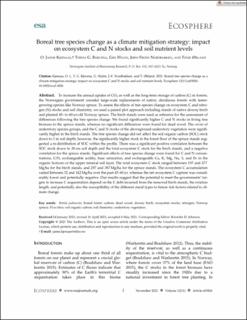| dc.description.abstract | To increase the annual uptake of CO2 as well as the long-term storage of carbon (C) in forests, the Norwegian government consider large-scale replacements of native, deciduous forests with faster-growing species like Norway spruce. To assess the effects of tree species change on ecosystem C and nitrogen (N) stocks and soil chemistry, we used a paired plot approach including stands of native downy birch and planted 45 – 60-year-old Norway spruce. The birch stands were used as reference for the assessment of differences following the tree species change. We found significantly higher C and N stocks in living tree biomass in the spruce stands, whereas no significant differences were found for dead wood. The cover of understory species groups, and the C and N stocks of the aboveground understory vegetation was significantly higher in the birch stands. The tree species change did not affect the soil organic carbon (SOC) stock down to 1 m soil depth; however, the significantly higher stock in the forest floor of the spruce stands suggested a re-distribution of SOC within the profile. There was a significant positive correlation between the SOC stock down to 30 cm soil depth and the total ecosystem C stock for the birch stands, and a negative correlation for the spruce stands. Significant effects of tree species change were found for C and N concentrations, C/N, exchangeable acidity, base saturation, and exchangeable Ca, K, Mg, Na, S, and Fe in the organic horizon or the upper mineral soil layer. The total ecosystem C stock ranged between 197 and 277 Mg ha-1 for the birch stands, and 297 and 387 Mg ha-1 for the spruce stands. The ecosystem C accumulation varied between 32 and 142 Mg ha-1 over the past 45-60 years, whereas the net ecosystem C capture was considerably lower and potentially negative. Our results suggest that the potential to meet the governments’ targets to increase C sequestration depend on the C debt incurred from the removed birch stands, the rotation length, and potentially also the susceptibility of the different stand types to future risk factors related to climate change. | en_US |

